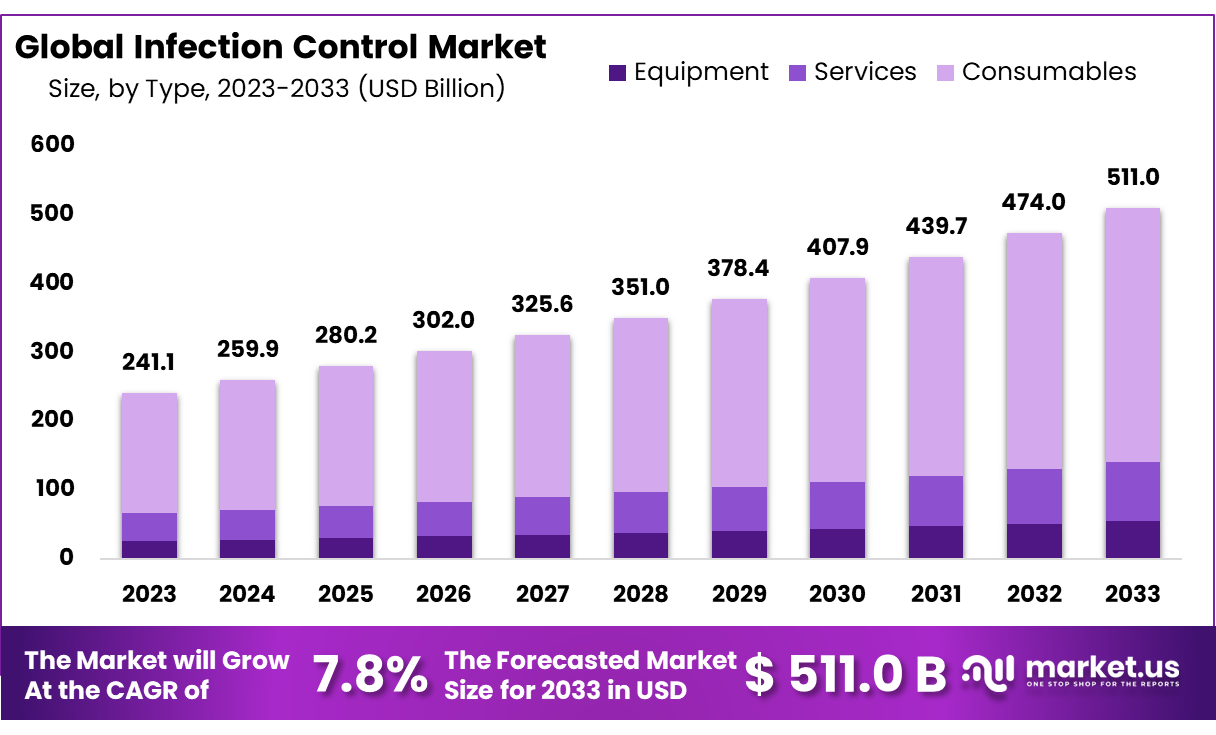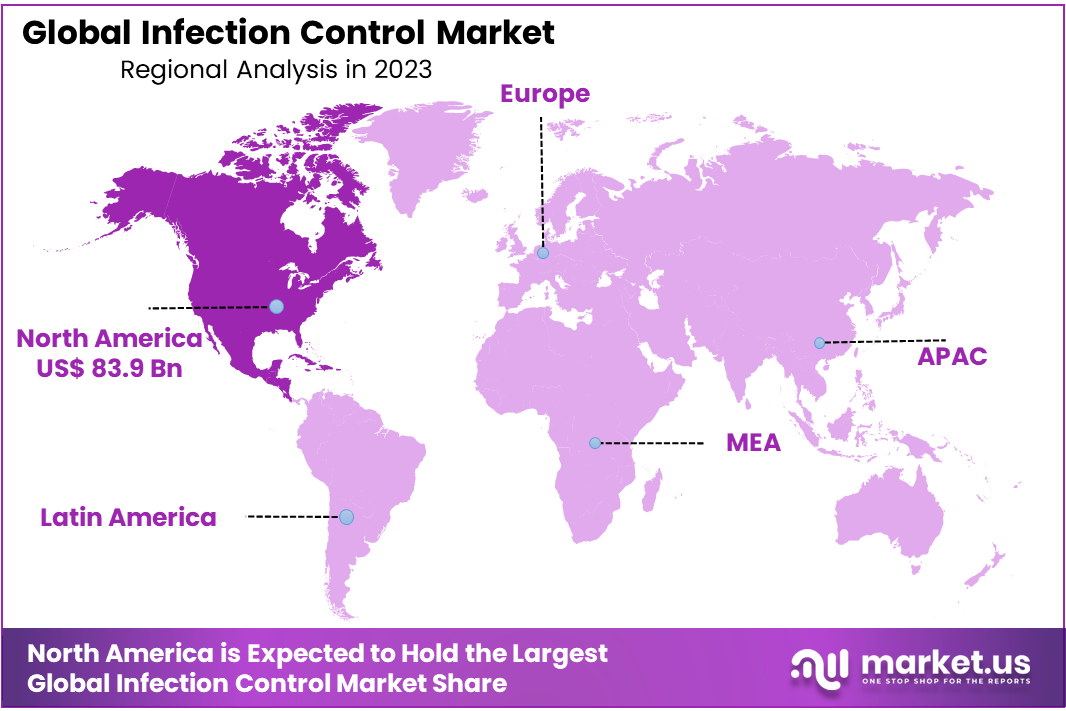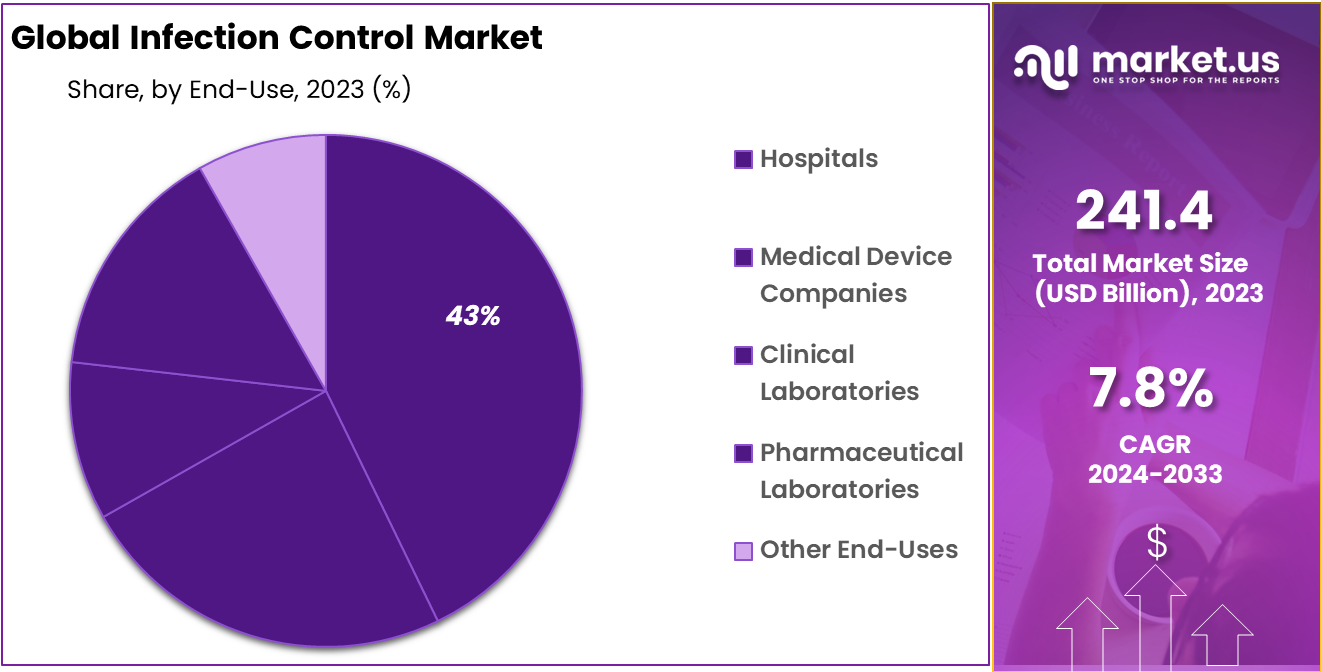New York, Feb. 14, 2024 (GLOBE NEWSWIRE) -- According to Market.us, the global Infection Control market size is forecasted to exceed USD 511 Billion by 2033, with a promising CAGR of 7.8% from 2024 to 2033.
Infections, stemming from microorganisms like bacteria, viruses, parasites, or fungi, encompass a variety of types, including digestive, respiratory, eye, ear, hospital-acquired infections (HAIs), skin infections, and sexually transmitted diseases. Infection control is highly valued for achieving positive clinical outcomes. The COVID-19 pandemic has notably influenced market growth, prompting an upsurge in sterilization services across hospitals, clinics, pharmaceutical companies, and medical device firms. This comprehensive market report offers an in-depth analysis of the Infection Control market, covering aspects such as size, share, growth opportunities, major factors, key trends, and various other critical elements.
Take a look at our sample PDF report @ https://market.us/report/infection-control-market/request-sample/

Key Takeaway:
- Based on type, the market is segmented into equipment, services and consumables. Among thsese, the consumables market claimed the highest market share, amassing 72.5%.
- By end-use, the market is bifurcated into hospitals, medical device companies, clinical laboratories, pharmaceutical laboratories and others. The hospitals segment remained the leading segment in the market with a market share of 42.8%.
- Region wise, North America contributed the most to the market and secured a market share of 34.8%.
Factors Affecting the Growth of the Infection Control Market:
- With rising health concerns, and government regulations the market has seen a
- Technological advancements have assisted in the process of market growth.
- Further, the process of market expansion is aided by the increasing awareness regarding hygiene, along with rising public awareness about risks associated with infections.
- One of the major restraints faced by the market is the budgetary concerns that limit the capabilities of healthcare facilities.
- Competing priorities often prove to be a major restraining force for the growth of the market.
Top Trends in the Global Infection Control Market:
Key trends in the infection control market include a surge in technological innovations, with automated disinfection systems and IoT-connected devices gaining prominence. There is a growing emphasis on data analytics and artificial intelligence for proactive monitoring and prevention. The market sees a rise in awareness due to recent global pandemic, driving increased demand for infection control products and services. Collaborative efforts between healthcare organizations and technology providers are fostering comprehensive solutions.
Additionally, there is an expanding market focus on personalized and targeted infection control approaches, adapting to the evolving landscape of healthcare needs and ensuring more effective prevention strategies.
Market Growth:
The infection control market is experiencing robust growth driven by various factors. Heightened awareness of healthcare-associated risks, particularly in the wake of global pandemics like COVID-19, is propelling the demand for infection control products and services. Technological advances, including innovative solutions like automated disinfection systems and IoT-connected devices, are significantly enhancing the efficiency of infection control efforts. The market is also expanding due to the increasing adoption of infection control practices, supported by government regulations and guidelines that emphasize compliance.
Moreover, the evolution of data analytics and artificial intelligence for monitoring and prevention offers proactive, data-driven approaches, contributing to the market's growth. Despite financial constraints faced by some healthcare facilities, the overall market is thriving with opportunities, driven by technological advancements, increased awareness, and the imperative need for comprehensive infection control measures globally.
Macroeconomic Factors:
Several macroeconomic factors influence the infection control market. Economic stability and growth play a pivotal role as they affect healthcare spending, impacting the resources available for infection control measures. Government policies, particularly in healthcare regulations and funding, significantly shape the market landscape. The level of public health infrastructure, including the availability of healthcare facilities and services, is crucial. Population demographics, such as aging populations in certain regions, contribute to the prevalence of healthcare-associated risks. Global health crises, like pandemics, reshape priorities and drive increased investments in infection control.
Technological advancements, driven by macroeconomic factors like research and development investments, influence innovation in infection control solutions. Currency exchange rates can impact the cost of imported medical supplies and technologies, affecting market dynamics. Overall, the macroeconomic environment, characterized by economic trends, policies, and global events, plays a vital role in shaping the trajectory of the infection control market.
Regional Analysis:
In 2023, North America stood as the most prominent market for infection control, contributing 34.8% to total revenues. The region's significant market share is attributed to strong collaborations with key industry players, enabling the expansion of product portfolios and improvement in infection control capabilities. The United States, with its predominant presence in North America, holds a dominant position in the market.
The Asia Pacific region is poised to exhibit the highest Compound Annual Growth Rate (CAGR) during the forecast period. This growth is fueled by increased healthcare spending, rising outsourcing trends, and the remarkable development of healthcare infrastructures and standards across the region. The presence of both voluntary and state-funded organizations striving to enhance infection control standards further influences the growth in the Asia Pacific market. Additionally, market leaders from developed countries are increasingly outsourcing to companies in the Asia Pacific, contributing to its key role as a growth driver. Organizations like the Asia Pacific Society of Infection Control actively work towards creating partnerships to improve quality and promote cost efficiency in the region.
Explore the strategic advantages our report holds for your business. Request a brochure to find out more https://market.us/report/infection-control-market/#inquiry

Scope of the Report
| Report Attributes | Details |
| Market Value (2023) | USD 241.1 Billion |
| Forecast Revenue 2033 | USD 511 Billion |
| CAGR (2024 to 2033) | 7.8% |
| North America Revenue Share | 34.8% |
| Base Year | 2023 |
| Historic Period | 2018 to 2022 |
| Forecast Year | 2024 to 2033 |
Market Drivers:
Healthcare Awareness Campaigns play a pivotal role as a driver in the growth of the infection control market. There is a heightened emphasis on raising awareness about healthcare-associated risks, a factor that resonates with both patients and healthcare providers. The understanding of the critical importance of maintaining safe and hygienic environments is driving the demand for infection control products and services.
Rising health concerns, particularly in the context of recent global pandemics like COVID-19, have significantly contributed to the surge in demand for infection control measures. The devastating impact of infectious diseases on society has prompted an unprecedented awareness, leading to an increased need for products and services that ensure infection prevention.
Furthermore, government regulations and healthcare guidelines emphasizing infection control practices play a crucial role. These regulations not only foster compliance but also actively drive the adoption of products and services related to infection control in various healthcare institutions. The combined effect of healthcare awareness campaigns, global health crises, and regulatory emphasis establishes a strong foundation for the growth and expansion of the infection control market.
Market Restraints:
Healthcare facilities encounter significant restraints in adopting robust infection control measures. One primary constraint is financial limitations, as many healthcare facilities operate under budgetary restrictions that hinder investments in advanced infection control solutions. This financial constraint impedes their ability to embrace cutting-edge technology or implement comprehensive infection control measures.
The cost of compliance with infection control regulatory standards poses another significant restraint. Meeting these standards often demands substantial financial investments from healthcare organizations, creating a strain on their available resources. This challenge is particularly pronounced for smaller or underfunded facilities.
Moreover, healthcare organizations grapple with competing priorities, including patient care, equipment acquisition, and staffing needs. The necessity to allocate resources across these various priorities can lead to restrictions in infection control measures. Limited funding, spread thinly across departments, can hamper the implementation of robust infection control protocols within healthcare facilities.
Market Opportunities:
The surge in technological advances presents a substantial opportunity in the field of infection control. Rapid strides in technology have given rise to inventive infection control solutions, including automated disinfection systems, Internet of Things (IoT)-connected devices, and telemedicine services. These advancements significantly enhance the effectiveness and efficiency of infection control efforts, providing a considerable advantage in combating the spread of diseases.
The integration of data analytics and artificial intelligence for monitoring and prevention holds significant potential. This approach allows for proactive, data-driven strategies in infection control, enabling real-time analysis to swiftly detect outbreaks and mitigate risks.
The heightened awareness of infection control has led to a broader market, offering opportunities for both established and emerging companies to provide comprehensive infection control products and services. This expansion allows for catering to diverse needs within the market, creating a favorable environment for growth and innovation in the sector.
Unlock Instant Access | Acquire This Premium Research Report https://market.us/purchase-report/?report_id=44350
Report Segmentation of the Infection Control Market:
Type Insight
In 2023, the 'Consumables' segment dominated the infection control market, contributing to 72.5% of the revenue share. This prevalence is attributed to the continuous use and shorter lifespan of consumables, which play a crucial role in sterilization, disinfection, and other control procedures. Notably, personal protective equipment constitutes a substantial portion of consumables, with many healthcare organizations advocating for its use and emphasizing its benefits.
Looking ahead, the 'Services' segment is anticipated to experience rapid growth during the forecast period. Services in infection control play a pivotal role by providing guidelines, recommending best practices, and advising on risk assessment and rational usage. Market players aim to reduce healthcare costs while maximizing benefits, and the Services segment is poised for accelerated expansion. This growth encompasses cost savings, improved service efficiency, and a heightened focus on core areas crucial for overall company profit growth and development.
End-Use Insight
In 2023, the 'Hospitals' segment emerged as the dominant end-use category in the infection control market, accounting for a substantial 42.8% of the global revenue share. This segment is projected to exhibit the fastest growth rate throughout the forecast period. Infection control practices play a vital role in places such as hospitals, laboratories, and medical device companies, where preventing the spread of infectious organisms is crucial. The high prevalence of infections in hospitals, particularly through blood-borne or respiratory pathogens, contributes significantly to this segment's prominence.
Hospital-acquired infections (HAIs) present a significant challenge, necessitating stringent control measures. Concerns about infections caused by blood-borne and drug-resistant pathogens are paramount. Instances like urinary tract infections (UTIs) linked to frequent catheter use further underscore the importance of infection control in hospitals. With UTIs representing a considerable portion of bacterial infections, this segment's growth potential is expected to be fueled by such factors in the future.

Tap into Market Opportunities and Stay Ahead of Competitors - Get Your Sample Report Now: https://market.us/report/infection-control-market/request-sample/
Recent Development of the Infection Control Market:
- In January 2023, 3M introduced antimicrobial Personal Protective Equipment (PPE), enhancing protection for healthcare workers against infectious agents. Cantel Medical launched an automated endoscope reprocessing system to streamline cleaning and disinfection, minimizing cross-contamination risks.
- In March 2023 the Association of Professionals in Infection Control and Epidemiology (APIC) released guidelines on ultraviolet (UV) lighting for disinfection in healthcare. A study in Infection Control and Hospital Epidemiology demonstrated the efficacy of hydrogen peroxide vaporization in significantly reducing healthcare-associated infections (HAIs).
- In June 2023, the FDA approved a new surgical mask for enhanced protection against airborne pathogens. A PLOS One study highlighted the effectiveness of a new hand hygiene product in reducing HAIs.
- In August 2023 the American Hospital Association (AHA) released a report on the financial implications of HAIs, while research in Clinical Microbiology and Infection emphasized the potential of an antimicrobial coating in significantly reducing catheter-associated bloodstream infections (CLABS).
Market Segmentation:
Type
- Equipment
-
- Disinfectors
- Endoscope Reprocessors
- Others
- Services
-
- Contract Sterilization
- Infectious Waste Disposal
- Consumables
-
- Infectious Waste Disposal
- Disinfectants
- Sterilization Consumables
- Personal Protective Equipment
- Others
End-use
- Hospitals
- Medical Device Companies
- Clinical Laboratories
- Pharmaceutical Laboratories
- Other End-Uses
By Geography
- North America
- US
- Canada
- Europe
- Germany
- France
- The UK
- Spain
- Italy
- Russia
- Netherland
- Rest of Europe
- Asia Pacific
- China
- Japan
- South Korea
- India
- New Zealand
- Singapore
- Thailand
- Vietnam
- Rest of APAC
- Latin America
- Brazil
- Mexico
- Rest of Latin America
- Middle East & Africa
- South Africa
- Saudi Arabia
- UAE
- Rest of MEA
Competitive Landscape:
Leading companies in the infection control sector, including Advanced Sterilization Products and STERUS Corporation, have adopted comprehensive collaboration strategies, intensifying competition in the market. These firms are strategically implementing various competitive measures, including mergers and acquisitions, to strengthen their positions. Additionally, there is a concerted effort towards developing new products, a strategy aimed at expanding their geographical reach and market presence. By actively engaging in collaboration and adopting competitive strategies, these major players aim to enhance their capabilities, foster innovation, and navigate the evolving landscape of the infection control market.
Market Key Players:
- 3M Company
- Belimed AG
- Halyard Health, Inc.
- Getinge Group
- Advanced Sterilization Products
- Matchana Group
- Sterigenics International
- MMM Group
- Cantel Medical Corporation
- STERIS Corporation
Explore More Life Science Market Research Reports
- Plasma Fractionation Market size is expected to be worth around USD 57.0 Bn by 2032 at a CAGR of 7.3% forecast from 2022 to 2032.
- Cosmetic Surgery Market size is expected to be worth around USD 186.5 Billion by 2033 from USD USD 82.5 Billion in 2023, at a CAGR of 5.1%
- In Vitro Fertilization Market Size Was USD 19.5 Bn In 2022 And is projected to reach USD 40.6 Bn By 2032, with a CAGR Of 7.8%, (2023-2032).
- Radiotherapy Market size is expected to be worth around USD 12.1 Bn by 2033 from USD 6.8 Bn in 2023, growing at a CAGR of 5.9%.
- Digital PCR Market is expected to grow at a CAGR of 15.3% over the next ten years and will reach US$ 1868.55 Mn in 2032.
- Assisted Reproductive Technology Market accounted for USD 31.85 Bn and is expected to reach around USD 179.4 Bn in 2032. at a CAGR of 19.4%
- Global Orthobiologics Market size is expected to be worth around USD 14.2 Billion by 2033 from USD 7.9 Billion in 2023, at a cagr of 6% during Forecast.
- Cannabidiol Market size is expected to be worth around USD 36.6 Bn by 2033 from USD 7.6 Bn in 2023, at a CAGR of 17.5% from 2024 to 2033.
- Surgical Microscopes Market size is expected to be worth around USD 3,020 Million by 2032 from USD 1,045 Million in 2022, at a CAGR of 11.50%
- Photodynamic Therapy Market Size Is Expected To Be Worth Around USD 5.5 Bn By 2033 From USD 2.4 Bn In 2023, Growing At A CAGR Of 8.3%.
About Us:
Market.US (Powered by Prudour Pvt Ltd) specializes in in-depth market research and analysis and has been proving its mettle as a consulting and customized market research company, apart from being a much sought-after syndicated market research report-providing firm. Market.US provides customization to suit any specific or unique requirement and tailor-makes reports as per request. We go beyond boundaries to take analytics, analysis, study, and outlook to newer heights and broader horizons.
Follow Us on LinkedIn
Our Blog:
